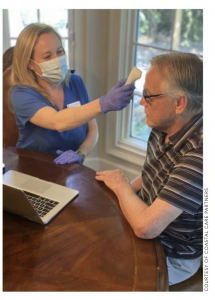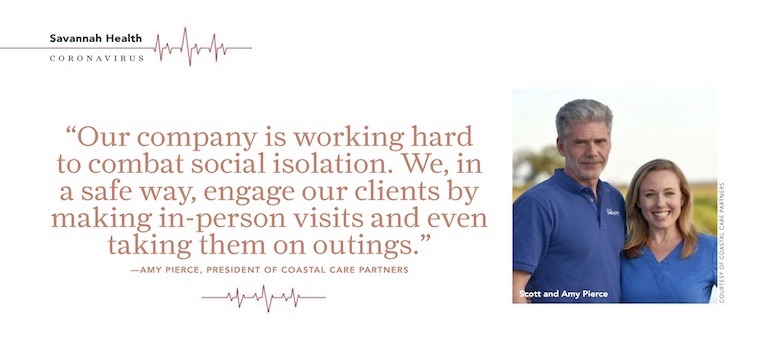Telehealth Keeps Medicine Moving
Source: Savannah Magazine
A few years ago, hospitals around the country tried to roll out a new way for patients and their providers to interact virtually, but it was a hard sell to convince people why they should convene with their doctor through a video screen when they could visit them face-to-face instead.
The coronavirus changed all of that.
Lawmakers hurried to pass legislation in early March that broadened the scope of reimbursements for telehealth and expanded the kinds of virtual services providers could offer without violating HIPAA privacy rules. Social distancing is imperative in keeping patients and providers safe. By avoiding sitting in a crowded waiting room, patients can limit exposure to the highly infectious virus.
Now, many area hospitals, private practices and wellness professionals are connecting with patients and clients virtually through telehealth video conferencing. It’s a welcome tool for people who are at risk or who simply prefer to stay home.
Memorial Health
Memorial Health began offering telehealth services in early April for nearly all of its practices and specialities. Doctor visits are now offered by Memorial providers from a patient’s smartphone or computer. Supported platforms for meetings include Apple FaceTime, Google Duo and WebEx Meetings, giving patients a range of options.
“This gives our patients the ability to see their doctors from the comfort of their own homes,” says internal medicine physician Dr. Nicole Cohen. “We’re doing all we can to make sure our patients are still able to connect with their trusted medical providers.”
Memorial Health’s pediatric department also began using telehealth appointments for children and their families to keep them out of crowded waiting rooms and safely at home.
“We all have felt the changes in our daily lives due to the coronavirus pandemic, and the outpatient medical world is no exception, even in pediatrics,” says pediatrician Dr. Andrew Gunter.
Though they encourage virtual meetings whenever possible, Memorial Health pediatricians are offering visits for sick patients in the morning and routine visits for well patients in the afternoons. The pediatric center is sanitized every 30 minutes, waiting room chairs are spaced six feet apart, and everyone entering the facility is screened at the door and given a mask.
At Memorial, telehealth has been a great tool for providers to examine and diagnose a range of health issues and routine checkups for patients of all ages.
“These visits have their limitations, but our feedback has been quite positive,” Gunter says. “We would hope to continue to offer this to our patients even after the pandemic subsides, as it has been a wonderful addition to patient care.”
St. Joseph’s/Candler
St. Joseph’s/Candler quickly embraced telehealth and virtual exams as the coronavirus ramped up in the community. Doctors from a range of specialties can now meet with their patients virtually from their homes before deciding whether they need to come into an office for closer examination.
Interventional cardiologist Dr. Michael Babcock, for example, can monitor a variety of health aspects of his patients remotely, thanks to blood pressure cuffs, remote stress tests and pacemaker monitors.
“Telehealth has been really helpful because many of our patients don’t want to come in or leave home,” Babcock says. “My view on telehealth has changed dramatically. Now, people can stay in their own homes, have a conversation about their health, and make sure their chronic medical conditions are being addressed.”
Babcock says many of his patients who once had to drive an hour or two for a doctor visit can now meet virtually with their provider from the comfort of home. However, there is a sense of personal connection that gets lost through a video screen, he says. Laying hands on patients is still the time-tested way to have the best sense of what is ailing them.
Before hopping on a telehealth call with your provider, Babcock has a few tips for making the experience as rewarding as possible: Keep any medications on hand for reference during the call, know your blood pressure readings ahead of time and have any questions for your doctor ready to bring up.
“Telehealth is another arrow in our quiver,” he says. “I’ve had some really positive feedback from patients. They don’t have to stop their life to see a doctor. Some people can do it on their lunch break from work. It’s definitely increased flexibility.”
Expercare
While large hospitals and health systems have embraced telehealth services for their patients, so too have local doctor’s offices and urgent cares.
ExperCARE CEO and founder Catherine C. Grant says the company’s use of telehealth ramped up this spring as patients needed immediate care but preferred to see a provider from the safety of home.
“Convenience and access to a health care provider from anywhere with a reliable connection are the undeniable advantages to utilizing telemedicine,” Grant says.
ExperCARE provides an initial evaluation for nearly all non-emergent patients through a telehealth platform, at which point providers determine whether it is best for the patient’s visit to be completed virtually or moved to an in-person visit, either curbside in the patient’s vehicle or inside the clinic.
Telehealth has proven convenient for initial patient consultations and routine follow ups, but it’s not without limitations, Grant says, noting the inability to perform certain diagnostic testing, like urinalysis or X-rays, and the inability to provide certain treatments, like suturing or splinting.
While virtual interactions can’t completely take the place of face-to-face interactions, Grant thinks telehealth will continue to play an important role in providing care to their patients moving past the pandemic and into the future.
“Telemedicine is here to stay,” she says. “It can’t replace all aspects of the evaluation and delivery of health care, but there is no doubt that it can and will help optimize the overall delivery model.”
Internal Medicine of Savannah
Internal medicine is one practice of health care in particular that benefits from the personal interaction of a physician and their patient, but Internal Medicine of Savannah has been able to pivot to offer telehealth visits nonetheless.
“The novel coronavirus changed the way we interact with one another,” says internist Dr. Yulianty Kusuma, who along with her team specializes in
the treatment of a range of conditions, including diabetes, hyperthyroidism and arthritis. “However, the continuity of care must carry on since there is no break in illness.”
In internal medicine, certain conditions could be overlooked when not closely monitored in-person, Kusuma says. However, many signs of internal illness can now be examined remotely through telehealth as technology and awareness improves.
“Some visible signs such as swelling and redness can be seen by camera,” Kusuma says, “and we are able to provide blood pressure and temperature checks if patients have the proper devices.”
Drawbacks include the fact that many patients do not have the access to the appropriate technology, or knowledge of how to use it, but Kusuma hopes as telehealth is more widely embraced, the possibilities of what providers can do for their patients will expand.
Shrink Psychiatry
Dr. Chad Brock, a board-certified psychiatrist who founded Shrink Savannah, has made use of telehealth and video conferencing to stay connected with patients during a lonely and trying time.
Virtual visits allowed providers at Shrink Savannah to stay in touch with their patients, and telehealth came in particularly handy for patients in college, who returned home to other states and regions during the shutdown.
“Initially, we thought we would only be doing appointments via telehealth for maybe a week or two,” Brock recalls. “As the situation developed and Georgia’s stay-at-home orders were announced, we quickly realized we had to embrace telehealth as our primary way to conduct business.”
As people begin to become more comfortable with returning to in-person meetings, Brock says telehealth technology will find its place in a provider’s toolbox, though it’s not a replacement for face-to-face visits.
“I don’t anticipate this being the future for mental health as it does not take the place of in-person dynamics and observations,” he says. “I do see it working for monthly visits where a high- functioning patient may not necessarily have any concerns, but just needs to check-in.”

Coastal Care Partners
Many of Coastal Care Partners’ clients are seniors who live at home and need help making sense of an often complicated health care regimen. Now, that also includes helping patients understand and utilize new advances like telehealth, which until just recently were not a routine part of care.
“Telehealth has gone from somewhat of a novelty to a best practice for elderly patients during the pandemic,” says Amy Pierce, president of Coastal Care Partners.
Coastal Care Partners team members help fill that gap between doctor and patient by taking diagnostics from the patient in real-time during the call. It’s an added layer of care for elderly patients who are at most risk of contracting the coronavirus from a crowded waiting room.
They work with primary care physicians, pulmonologists, cardiologists, oncologists, orthopedics, surgery follow-ups, hospital discharge follow-ups and more. Coastal Care Partners nurses are able to give injections, perform blood draws, offer wound care, and other services for which elderly patients would otherwise need to visit a clinic.
“We make sure the strategy the doctor has laid out is executed,” Pierce says. “We monitor and assist with medication management, and any other instructions that the doctor prescribes.”
Though telehealth has served as a great way to keep patients safe, Pierce says their senior population still enjoys getting dressed up to visit their doctor, something many think of as a social event.
“While some of that may have been lost, our company is working hard to combat social isolation,” Pierce adds. “We, in a safe way, engage our clients a good bit by making in-person visits and even taking them on outings where we monitor their distancing and ensure they are safe, but at the same time, maybe they can go for a walk or car ride to get outside and see the world.”
New Yoga Now
Yoga can ease stress, relieve anxiety and may help decrease inflammation. Fortunately, devotees can glean these same proven benefits at home. Since the coronavirus outbreak, New Yoga Now is one of many area studios that has opened up classes online to keep customers and instructors safe, says co-founder Kendall Beene. The studio live-streams group classes, kids’ yoga classes, workshops and teacher training courses.
“This pandemic has definitely opened our minds to the effectiveness of online yoga classes and especially online teacher training courses,” Beene says. “We have been absolutely delighted by the connections the trainees are making with each other and with themselves in the virtual format.”
Virtual yoga has its pros: it allows New Yoga Now’s teachers to reach a broader audience than the yoga studio usually can hold, Beene says, and people are less shy about joining a yoga class when they don’t have to worry about being watched by others in the classroom. Still, Beene admits the virtual atmosphere creates a barrier to the community-building aspect of yoga that many participants enjoy.
“There will always be folks who thrive on the group energy of in-person yoga, so we don’t see studio classes going anywhere as long as it is safe to gather,” Beene says

